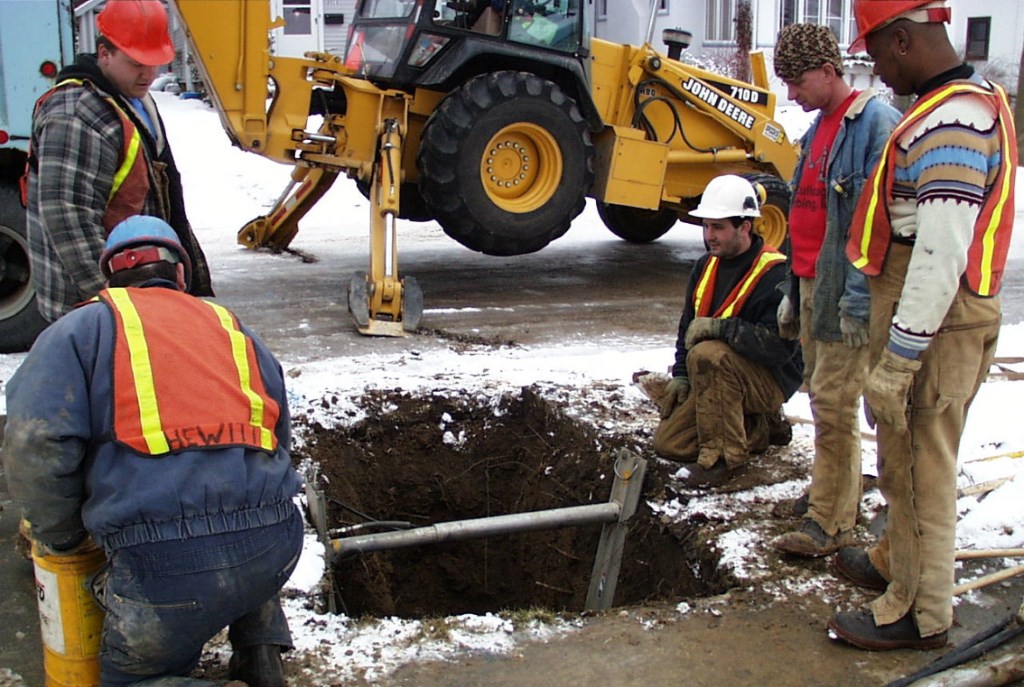Madison Replaced All Lead Pipes
Nation's first city to do so, at cost of $19.4 million, can Milwaukee follow suit?

City of Madison crews replace lead service lines leading into a home. The city’s decade-long lead pipe replacement program, begun in 2001, is considered a model of how to remove harmful lead from municipal water systems. Current federal regulations require only replacement of utility-owned lead pipes, which can increase rather than decrease lead levels in water. Photo from the Madison Water Utility.
The Madison Water Utility was the first major utility in the nation to demonstrate that a full replacement of both the public and the private portions of lead service lines was possible.
But it was neither easy nor cheap. “It was quite a contentious thing,” Tom Heikkinen, the water utility’s current general manager, said at a regulatory meeting in May 2015. “I’m glad I wasn’t here at the time.”
The effort to replace all of Madison’s lead pipes took more than a decade beginning in 2001, and cost roughly $19.4 million. About 20 percent of the cost was borne by homeowners. The city covered half the cost of replacement, up to $1,000, for the 5,600 property owners who participated.
Robin Piper, the utility’s financial manager at the time, said the solution “made the most sense in the long run.” It made the city’s drinking water safe and did not pollute Madison’s lakes with orthophosphate, an anti-corrosive that was the other solution Madison could have chosen for preventing lead from leaching into water.
As the Milwaukee Journal Sentinel reported, a survey by the Milwaukee Legislative Reference Bureau of nine other eastern cities found Milwaukee had the most lead laterals: there are 60,000 in Philadelphia, 45,000 in Cleveland, 40,000 in Boston and 35,000 in Dayton, Ohio. Five other cities had 20,000 or fewer lead laterals.
City Health Commissioner Bevan Baker has called this a problem with potential health risks, particularly for young children, pregnant women and breast-feeding mothers. In a letter sent to state officials, Baker asked them to create a partnership with municipalities “to remedy this situation on behalf of all citizens in Wisconsin.”
Cost is not the only barrier to replacing all lead pipes, said Amy Barrilleaux, spokeswoman for the Madison Water Utility.
“Just getting Madison’s lead service replacement program approved by lawmakers and the agencies that oversee us took years, not counting the actual pipe replacement work itself, which took another decade,” she said. “It’s not surprising that other utilities have been reluctant to go down that path, but we’re glad we did.”
Speaking at the May regulatory meeting, Steve Elmore, the Wisconsin Department of Natural Resource’s public water supply chief, said because of Madison’s project, Wisconsin has “had a big part” in the current effort to rewrite the federal Lead and Copper Rule. An advisory panel has recommended that any updates to the rule require utilities to pursue full replacement of all lead service lines with customers.
Even full replacement of pipes must be approached with caution to avoid dislodging lead particulates that could linger in the tap water for several years, according to a study of Madison’s lead levels after the full replacement program.
One of the authors, Abigail Cantor, a Madison-based chemical engineer and technical consultant, had this message for water utility managers: “If we are going to replace these pipes, it has to be done correctly. … Lead is a bad substance. The level that humans can tolerate without any severe effects is zero. So let’s try to get the lead out of our water systems.”
This story was produced as part of The Confluence, a collaborative project involving the Wisconsin Center for Investigative Journalism and University of Wisconsin-Madison School of Journalism and Mass Communication reporting classes. The nonprofit Center (www.WisconsinWatch.org) collaborates with Wisconsin Public Radio, Wisconsin Public Television, other news media and the UW-Madison School of Journalism and Mass Communication. All works created, published, posted or disseminated by the Center do not necessarily reflect the views or opinions of UW-Madison or any of its affiliates.
Tainted Water
-
Fecal Microbes In 60% of Sampled Wells
 Jun 12th, 2017 by Coburn Dukehart
Jun 12th, 2017 by Coburn Dukehart
-
State’s Failures On Lead Pipes
 Jan 15th, 2017 by Cara Lombardo and Dee J. Hall
Jan 15th, 2017 by Cara Lombardo and Dee J. Hall
-
Lax Rules Expose Kids To Lead-Tainted Water
 Dec 19th, 2016 by Cara Lombardo and Dee J. Hall
Dec 19th, 2016 by Cara Lombardo and Dee J. Hall




















Why should the city of Milwaukee divert precious resources to digging up & replacing perfectly good infrastructure? The pipes are not leaching any lead and have no prospects to do so.
Can Madison show that the lead levels in their drinking water have dropped?
Let’s see the F35 airplane program will cost about $1 trillion for a plane that has yet to meet ANY of its planned “parameters of performance” except it can fly, maybe! Replacing the lead pipes in Milwaukee will cost less than 1/1000th of that, probably create more jobs, and offer residents more safety! But which do we do without question of any elected or appointed “leaders”? We can do this if we want to but we need to re-think what security and national defense means. OOOPS I forgot those people living in Milwaukee probably haven’t ponied up the tens of millions for a super pac – never mind!!
This lead issue is not new. A lot of other communities like Madison addressed this issue and put them together with other infrastructure repairs and got them done. Milwaukee did not. Now lead is a big problem for Milwaukee. Barrett failed Milwaukee here.
Of course you will never read a critical word about Tom Barrett on the Urban Milwaukee site or from Bruce/Jeremy or other bloggers at Urban Milwaukee which does nobody any good.
Allison, why is lead a problem for Milwaukee? Explain yourself.
“Now lead is a big problem for Milwaukee.”
Do tell.